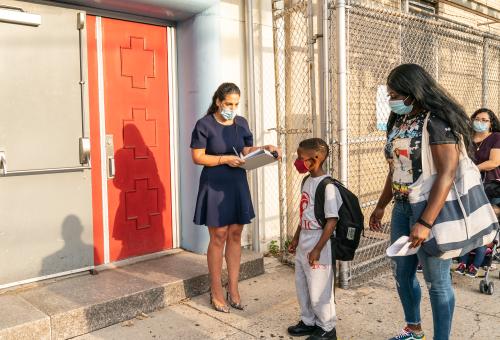When Alison Harris Welcher became principal of Ranson I.B. Middle School in Charlotte, NC, it was one of the lowest-performing schools in the district. “We had teenagers who couldn’t read,” Welcher recently explained in testimony before the U.S. Senate. “There were classrooms full of kids where no learning was happening.”
Four years later, Ranson had exceeded all of its growth targets and was one of the top 25 schools in the state on the growth composite index measure.
Welcher’s success defies the all-too-common pessimism regarding the possibility of improving struggling schools. “There is a real difference between maintaining excellence and building it,” said Welcher. “School transformation is hard, it takes time, and it is possible.”
The Every Student Succeeds Act (ESSA), our new federal education law, grants states and districts more freedom to develop locally-tailored strategies for improving the lowest-performing schools while also requiring them to use approaches supported by evidence. As they grapple with implementation of ESSA, our school systems have much to learn from Welcher’s experience and other great principals like her.
Research (including by the U.S Department of Education, the Wallace Foundation, and the UChicago Consortium on School Research) has found that effective leadership is a critical driver of school turnaround. While multiple factors contribute to school transformation, ensuring struggling schools are led by a well-prepared, well-supported principal can and should be a central strategy for improving them. But what exactly does effective school leadership look like? What skills and knowledge do outstanding principals possess? And what actions lead to success?
We set out to answer these questions by studying more than 100 school leaders who, like Welcher, have overseen significant achievement gains in district and charter schools serving our country’s most vulnerable and at-risk students. Although such principals often seem like one-of-a-kind superheroes, we found that their success derives from a surprisingly uniform set of practices that, when carried out with fidelity, consistently result in significant school improvement.
These practices, which we describe in our new book, Breakthrough Principals, include:
- Undertaking a comprehensive diagnostic process to identify priorities and develop (and continuously revise) action plans.
- Establishing a clear mission and vision for their schools and systematically fostering buy-in among staff, students, and families.
- Cultivating leadership in adults across the school and building a strong team to help shoulder leadership responsibilities.
- Adopting a standards-aligned curriculum and creating time for teachers to collaborate on unit and lesson plans as well as data analyses to understand student progress.
- Demonstrating strong personal leadership by building trust with their staff, managing change with sensitivity and optimism, and modeling self-reflection.
Turning around struggling schools is not easy. But, as these top-performing principals demonstrate, it is methodical and, therefore, can be taught. Unfortunately, too few programs currently equip school leaders with concrete skills that will help them succeed. In fact, Public Agenda found that 41 percent of superintendents report principals are not well-prepared for the job. To scale the results of successful principals, leadership preparation programs and district professional development must provide better training and support.
Specifically, states can:
- Upgrade how they review and approve principal preparation programs, ensuring programs provide competency-based training in the skills necessary for transformational school leadership and opportunities for real-world practice (g., through residencies under skilled principals).
- Reform the initial principal licensure process so it looks at characteristics that are associated with successful school leadership—a strong belief that all students can achieve at high levels, a record of success in the classroom, and mastery of key adult and instructional leadership skills—and ensure license renewal is based on demonstrated effectiveness once on the job.
- Encourage district conditions that allow well-prepared school leaders to maximize their impact, including by providing them with balanced autonomy over budgets, staffing, and schedules, and ensuring they are supported and managed by skilled supervisors.
- Develop and support other approaches to leadership development that have a record of positively impacting student outcomes, and provide technical assistance to help districts identify such evidence-based programs and partners (g., by using this helpful RAND Corporation report).
ESSA includes a number of opportunities to support these efforts. States can use a new opportunity in Title II to dedicate a portion of funds from the state grant specifically for school leadership; they can use this to make necessary investments and create a statewide infrastructure focused on ensuring every school is led by a well-prepared, well-supported principal. Moreover, they can use those funds to build local capacity to foster strong leadership policies and practices—particularly in struggling districts or those that are supporting large numbers of schools identified for improvement, where school leadership is especially crucial. States can also leverage Title I dollars to invest in evidence-based leadership programs for the lowest-performing schools identified for comprehensive support and improvement.
To make good on the promise of local control, we must learn from the successes of principals like Welcher and ensure all school leaders—especially those committed to working in the highest-need schools—are prepared and supported to deliver strong results for the teachers, students, and communities they serve.






Commentary
Turning around struggling schools is not easy but can be taught
8/11/2016